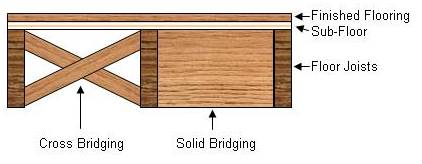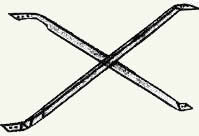Causes Of Squeaky Floors:
- Lack of bridging between floor joists or twisted or warped floor joists.
- Damaged floor joists.
- Separation of sub-floor from joists.
- Twisted, bowed, split or warped floor boards.
- Lack of bridging between floor joists or twisted or warped floor joists.
- Lack of bridging between floor joists or twisted or warped floor joists.
- Use a small hydraulic jack to separate the joists.
- Use a furniture or bar clamp to draw the joists together.
A lack of bridging between floor joists is one of the most common causes of squeaky floors, especially in older homes. Bridging is the piece or pieces of lumber that tie the floor joists together between supports. Bridging distributes the floor load and prevents the floor joists from twisting and warping which results in sub-floor or floor fasteners being loosened.
Bridging, as shown in Figure 1, can be a solid piece of lumber, "solid bridging", usually the same dimensions as the floor joists or the bridging can be accomplished with cross pieces of lumber or metal, "cross bridging".

Figure 1 - Solid and cross floor joist bridging
Bridging is often removed to allow for the installation of HVAC ducts, dryer vents, plumbing and electrical services within the home. The older the home the more likely that renovations and remodel trades have removed pieces of bridging in order to accommodate new services.
Bridging should be installed in any run that exceeds eight feet. For runs between 12 and 18 feet, there should be two sets of bridging. Runs that exceed 18 feet should have bridging at a minimum of six foot intervals, evenly spaced across the length of the floor joist.

Figure 2 - Metal floor joist bridging
Although I believe that wood is the best material to use for bridging, metal bridging products are also available (Figure 2) and are used frequently in new home construction. They are difficult to use in a retrofit situation as they are designed to be fastened to the top and bottom of the floor joists rather than the sides.
Without bridging the load is not distributed to multiple floor joists, hence individual floor joists are carrying all the weight and can spring when walked on, this can result in squeaking. As well, without bridging between floor joists, the floor joists can twist and warp out of shape, as shown in Figure 3, resulting in the following scenario:

Figure 3 - Warped floor joist
To correct the problem it is necessary to add bridging.
Solid bridging is easier to add than cross bridging, as cross bridging is difficult to nail once the sub-floor has been installed. The bridging must be added across the full width of the floor. If it is not added across the full length of the floor, it is likely that the squeak will move from the area where the bridging has been installed to an area where the bridging has not been installed.
Before the bridging can be installed it is necessary to straighten the floor joist or joists that are twisted.
There are two methods that can be used to straighten the floor joist and in some cases it is necessary to use both, as shown in Figure 4.
Note: It is usually easier to position the bar clamp first and then insert the jack to maintain the separation.

Figure 4 - Using jack and clamp to straighten twisted, warped floor joist
Once the joist is straight, cut pieces of lumber, the same dimensions as the joist and insert them between the joists that have been straightened, as shown in Figure 5.

Figure 5 - Solid bridging installed after straightening twisted, warped floor joist
Then proceed on to the next joist, continuing in this manner until bridging has been added across the full width of the floor joists.
